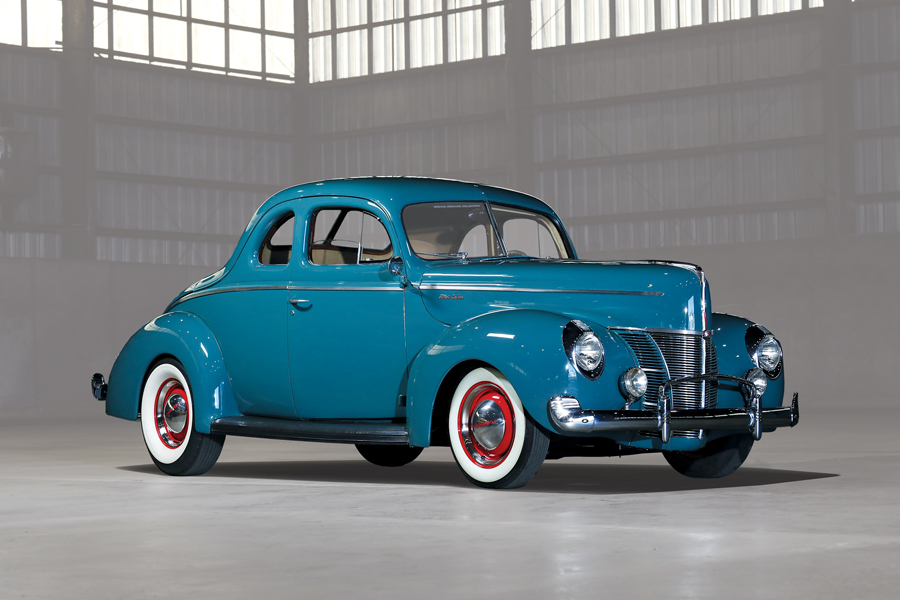- Restored in original Showroom Green
- 221-ci flathead engine
- Offenhauser aluminum heads
- 3-speed manual
- Corduroy seat covers
- From the Vault Portfolio
SCM Analysis
Detailing
| Vehicle: | 1940 Ford DeLuxe Coupe |
| Years Produced: | 1940 |
| Number Produced: | 27,919 (DeLuxe Coupe only) |
| Original List Price: | $721 |
| SCM Valuation: | $41,800 |
| Tune Up Cost: | $200 |
| Chassis Number Location: | Left side frame member near firewall |
| Engine Number Location: | Top of the bellhousing |
| Alternatives: | 1937–42 Chevrolet Master Coupe, 1936–42 Hudson, 1939–40 Mercury Eight |
| Investment Grade: | C |
This car, Lot 721.1, sold for $46,200, including buyer’s premium, at the Barrett-Jackson Northeast 2019 auction, held June 29, 2019, in Uncasville, CT.
1940 was the final year of a generation of Fords that began in 1937. The 1941 Fords were completely redesigned, with two inches more wheelbase, and were about six inches longer overall.
It’s generally agreed that the restyle ruined the glamorous lines of the 1939 and 1940 Fords. The 1941 design carried on through the war to the end of the 1948 model year, making the 1940 coupe the last and best pre-war Ford of its kind.
Rapid change
Competition with Chevrolet was fierce in the late 1930s. Ford made significant styling and mechanical updates to its passenger-car line every year. Starting with the 1937 model year, Ford offered two versions of its flathead V8 engine. Buyers could choose a 136-ci engine with 60 horsepower and 94 foot-pounds of torque, or a larger 221-ci design with 85 horsepower and an impressive 153 ft-lb of torque.
Fords of this generation started with mechanical brakes all around. Ford upgraded to Lockheed hydraulic brakes in 1939. A 3-speed transmission was standard, and beginning in 1940, the shifter moved from the floor to the steering column.
This era was also significant for rapid developments in styling. These were the first Fords to have an all-steel roof, the headlights were moved out to the fenders, and 1940 was the first year for sealed-beam headlights.
Through the latter 1930s, Standard trim models carried the previous year’s DeLuxe styling. That was a canny marketing move to get status-conscious DeLuxe buyers to invest in a new car every year. The 1940 DeLuxe was the final and most beautiful expression of designer Eugene Gregorie’s vision.
Subtle custom
Our subject car came from the Vault Portfolio — a collection of top-quality restorations, customs and hot rods. The car is finished in an original color called Showroom Green, although it presents more as a blue. As is typical of Vault Portfolio cars, this Ford has been very respectfully customized. It’s easy to imagine that this is how this car would have been modified in the immediate post-war period.
That means there’s no cacophony of chrome shrouding an LS-series engine when you look under the hood. The correct 85-horse flathead engine and column-shifted 3-speed transmission are in place. Custom engine work includes an extra carburetor and period-correct Offenhauser heads. A modern battery is the only anachronistic note in the engine bay.
The sale photos did not include interior shots, but the description notes that the original corduroy upholstery has been restored. A few options are visible from a distance, including gravel-deflecting winglets on the bumper ends, a front bumper guard, fog lights and whitewall tires. All were factory options in 1940.
Finally, a little rake has been added to the car by dropping the front end. Thank the hot-rod gods that no one has been so tasteless as to install modern wheels. Proper stamped steel wheels, Ford DeLuxe hubcaps, whitewalls and beauty rings complete the look. This is a car you could take to any show on Earth and receive accolades.
A very good buy
In the past year, 38 Ford Standard and DeLuxe coupes from 1938 to ’40 have crossed the block. Prices have ranged from $19,250 (ACC# 6899520) to $110,000 (ACC# 6894927), but what is notable is the sell-through rate.
Of those 38 cars, 32 have sold at every price point between the extremes. That tells us that there’s plenty of action in the market, and that sellers are generally taking the bids they receive. This is the pattern of “get out while you can” from a market with a declining future, yet every one of those cars found a willing buyer. That proves the strength and appeal of this generation of Ford coupe, if not a rising market.
Against that backdrop, the buyer of this car got a very good deal. Once a classic is updated with Mustang II front suspension, tilt steering column and a drivetrain swap, there’s usually no going back. What’s more, that kind of custom is usually attractive only to the person who built it.
While this car is technically a custom, it can appeal to purists as well. With this purchase, the buyer got a slice of hot-rod history, professionally prepared and maintained. Many buyers have paid far more and taken home much less.
The only surprise is that this car didn’t pull higher bids. While the sale price is right in the fat part of the bell curve, this stunning example was very well bought.
(Introductory description courtesy of Barrett-Jackson.)
